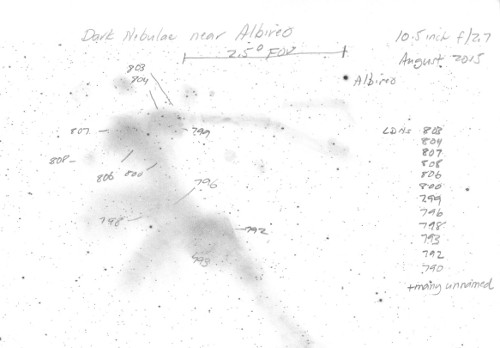Preparing for a night's observations, Mel Bartels
I start by selecting objects:
- From a list like Sue French's columns in Sky and Telescope magazine
or
- I return to a previously list of objects or
- create a list of objects based on some criteria, like bright and
dark nebulae in Cygnus. There are a great number of observational books
that describe objects - ideas on what to observe abound.
Recently I was studying the region near the double star Albireo in
Cygnus using the Milky Way panorama at Photopic Sky
Survey. I noticed intriguing bright and dark nebulae jutting from
Albireo a couple of degrees to a complex. I decided to observe this
area.
Preparing the list of objects
- I lookup various material (online, offline and printed) including
images and text, gathering it in the form of pdfs and textfiles, rarely
printed material
- I review others' observations and images
- I think about the best time in the evening to view the object in
relation to other objects that I want to see
- I consider nearby objects out of curiosity
- I consider how I am going to star hop
I searched for digital images, checked SkyTools and SkySafari and the
Barnard atlas as well as the Lynds catalog.
Later at the eyepiece
- I loosely follow my star hopping strategy
- I record notes and draw incomplete sketches as I study the
objects
- I also record environmental conditions (transparency, seeing,
location) and telescope conditions (aperture, magnification, apparent
field of view, filters)
I observed the region over several hours on a couple of nights.
Afterwards
- I draw a cleaned-up sketch, post results online

Improvements (missing compelling features) and frustrations:
- Translating from observing lists in books and online is a manual
process
- Gathering information about an object is scattershot and more work
than it should be
- Not enough provision to select a body of objects based on observing
based criteria such as region, size, object characteristics (edge on
galaxies)
- Starhopping using planetarium programs like SkySafari is
frustrating, particularly the inability to keep an object the focus of
the app (an accidental tap means redoing the search)
- Easy to ruin night vision in order to read small print and see
detailed star fields on the tablet
- Lack of feedback where scope is being pushed back and forth during
star hopping
- Cannot easily generate prominent star fields (circular shaped) for
sketching
- Cannot easily draw on/at the tablet (drawing apps not particularly
suited to astronomical needs like stars of varying brightness and
regions of varying brightness)
